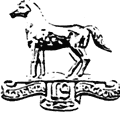Alfred David Marfleet

.jpg)
The 19 Brigade Victory at Paardeberg - February 1900
As will be noted later, Alfred David spent twelve years in the Duke of Cornwall's Light Infantry. This means that he must of signed up as a boy soldier circa. 1897 when he was 15 years of age. This was year his father remarried but it was not a long marriage as Alfred senior died the following year, 1898.
In 1897 the Duke of Cornwall's were engaged in a campaign which was fought on the North-West Frontier in which the Battalion took part in the Tirrah expedition, seeing active service in Tirrah and the Bara Valley.
During the next two years they were stationed at Peshawar, Rawal Pindi and Lucknow (1898-1899) and Calcutta and Dum-Dum (1900).
In 1901, prisoners of war from South Africa were shipped over to Ceylon to hastily constructed camps, and the First Battalion was given the task of guarding them. The following year they sailed for South Africa as part of the army of occupation, and were stationed at Stellenbosch (1902) Middleburg and Cape Colony (1903) and Wynberg (1904-05).
In 1906, the Battalion returned to England where they were initially quartered at Crownhill Barracks, Plymouth. From there they moved to Woolwich (1907), Gravesend (1908-1910) and Tidworth (1911).
It was around 1909 that Alfred David left the army and emigrated to Canada. Accounts of other trail-blazers tell of him taking the arduous 200 mile trail from Edson to Grande Prairie with them in the severe winter of 1910 when it was so cold that icicles had be removed from the nostrils of the horses hauling the caboose to allow them to breathe.
Western Land Grants (1870-1930) from the National Archives of Canada, record Alfred claiming Part NW, Section 25, Township 71, Range 6, Meridian W6 but it is not yet known if this was his first claim or a known subsequent claim.
Soon after he arrived in Grande Prairie, Alfred enlisted with the 19th Alberta Dragoons (19th Alberta Mounted Rifles authorized 1 Feb 1908 - redesignated 19th Alberta Dragoons 3 Jan 1911) a Canadian Militia cavalry regiment with headquarters at Edmonton and squadrons at Edmonton and Vegreville, and he served with them for two years before intending to settle down to homesteading. However, events in Europe were to change his plans. As a result of the outbreak of war he made an application on the 22nd July, 1915, to enlist with the Canadian Overseas Expeditionary Force. The Attestation Paper shows that he was 33 years of age, 5' 4½" in height with a chest girth of 33" and a range of expansion of 3½". His complexion was described as 'Brunette', his eyes, 'Hazel' and his hair, 'Brown'. He had tatoo marks on both his right forearm and his left forearm, and he was unmarried.
Everything appeared to be satisfactory, but there is an engima. The Certificate of Officer Commanding Unit was never signed. The puzzle is, why not? There is a clue on the form, but the reason is not straight forward. An endorsement on the left hand side reads: R.D. 120, L.D.15. and herein lies the puzzle. R.D. and L.D. are abbreviations normally associated with eyesight when the measurement figures could be, for example, 20/40, but the figures presented, 120 over 15 would normally be associated with blood pressure. If this is the interpretation, the systolic pressure (when the heart contracts) of 120 millimetres of mercury could be regarded as normal, but the diastolic pressure (when the heart relaxes) of 15 would be very low when the normal is around 70. Was Alfred suffering from low blood pressure on that day?
Whatever the reason for his being declined for active service, a subsequent application eight months later on the 13th March, 1916, was successful. It is on this application form that Alfred gives details of previous military service, 12 years with the Duke of Cornwall's L.I., 5 under colours and 7 reserve, and 2 years with the 19th Alberta Dragoons (although unfortunately no dates are given).
With the cessation of hostilities Alfred returned to Grande Prairie.
32nd Light Infantry (Duke of Cornwall's)
County Regiments - Duke of cornwall's Light Infantry

.jpg)